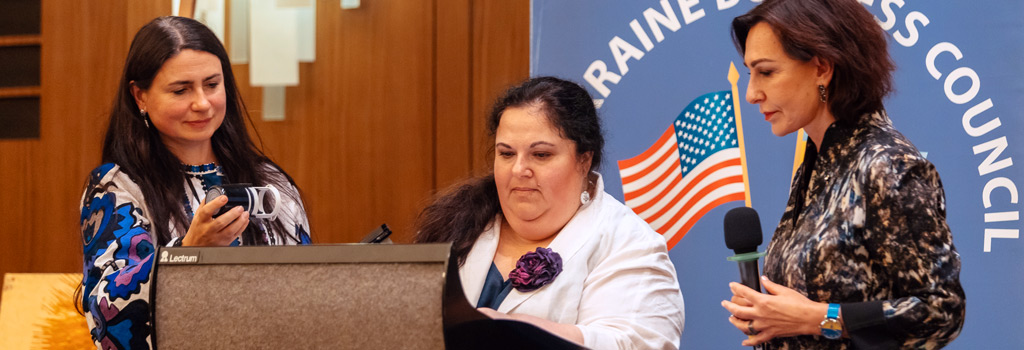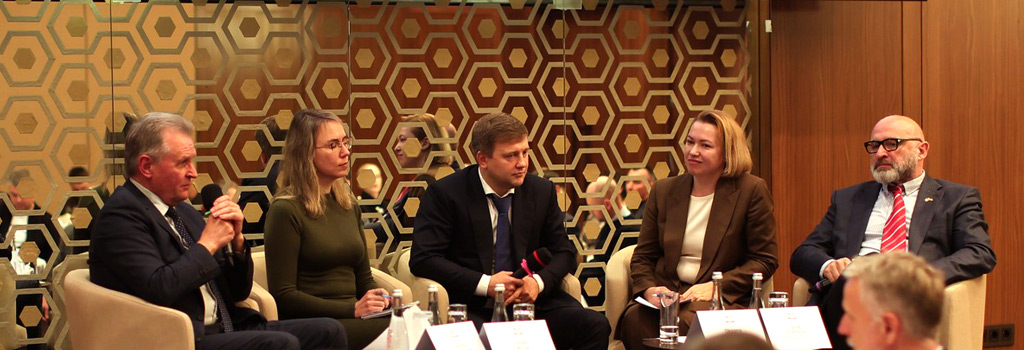Featured Galleries USUBC COLLECTION OF OVER 160 UKRAINE HISTORIC NEWS PHOTOGRAPHS 1918-1997
 Holodomor Posters
Holodomor Posters

UKRAINE - MACROECONOMIC SITUATION – APRIL 2017
 ANALYTICAL REPORT: by Oleg Ustenko, Djulia Segura, Valentyn Povroznyuk, Edilberto L. Segura
ANALYTICAL REPORT: by Oleg Ustenko, Djulia Segura, Valentyn Povroznyuk, Edilberto L. Segura
SigmaBleyzer private equity investment management firm & The Bleyzer Foundation (TBF), Kyiv, Ukraine
LINK: UKR_MONTHLY_EC_REPORT_APRIL 2017_FINAL.PDF
Published by U.S.-Ukraine Business Council (USUBC),
Washington, D.C., Fri, May 12, 2017
ANALYTICAL REPORT: by Oleg Ustenko, Julia Segura, Valentyn Povroznyuk, Edilberto L. Segura SigmaBleyzer multinational private equity firm & The Bleyzer Foundation (TBF), Kyiv, Ukraine
Published by the U.S.-Ukraine Business Council (USUBC), Washington, D.C., Thursday, May 11, 2017
WASHINGTON, D.C. - The "Ukraine Macroeconomic Situation – April 2017" analytical report is found below and as an attachment to this communication. The monthly macroeconomic situation report is prepared by the SigmaBleyzer multinational private equity firm, www.SigmaBleyzer.com, and The Bleyzer Foundation (TBF), www.BleyzerFoundation.org, Kyiv, Ukraine, who are members of the U.S.-Ukraine Business Council (USUBC), http://www.USUBC.org.
NOTE: The complete Ukraine - Macroeconomic Situation - report for April 2017 in PDF format, with a series of important, color charts and graphs, can be found in the attachment to this e-mail.
EXECUTIVE SUMMARY -----
(1) The ceasefire in Eastern Ukraine -- a base condition of the Minsk-2 Agreement -- continues to be violated by the Russian-backed separatist. Rebels continue to fire against Ukrainian militants using
different weapons, including heavy artillery which are strictly prohibited by Minsk. International pressure has been building to persuade Russia to rectify this situation.
(2) In April, the key items in the reform agenda of the Ukrainian government remain those agreed with the IMF (i) pension system reform, with a draft law expected in May; (ii) land market reform,
with an initial stage consisting in the sale of government land; and (iii) fighting corruption, with more energetic action against corrupt officials.
(3) The Ukrainian economy is recovering from the downturn caused by the trade blockage in Eastern Ukraine in February. Following a decline in manufacturing output of -3.2% yoy in February,
manufacturing in March increased by 3.0% yoy. Furthermore, in March construction output increased by 11.5% yoy, retail trade by 8.7% yoy, and freight turnover by 4.2% yoy. The agricultural
sector also had positive results with a 0.8% yoy increase in output in March, compared to 2.5% yoy and 1% yoy reductions in January and February 2017.
(4) Both fiscal revenues and expenditures of the state budget experienced deceleration of their growth in March. However, expenditures grew faster, leading to a state budget deficit of UAH 11.1
billion. In addition, local budgets were executed with the deficit (UAH 2.9 billion). These developments led to significant decline in the consolidated budget surplus from the beginning of the year
to UAH 4.0 billion during January-March.
(5) Consumer inflation accelerated in March, with CPI increasing by 15.1% yoy. But core inflation declined to 6.3% yoy. Therefore, we maintain our forecast of 10% inflation in 2017.
(6) In March, bank deposits in national currency grew by 14.2% whereas deposits in USDs declined by 3.4% yoy. Bank lending activities remained sluggish in March but showed some signs of
reactivation. In particular, household national currency loans posted the 0.7% yoy increase which is the first increase over the last 2.5 years.
(7) The UAH/USD exchange rate appreciated at a slow pace for the whole of April to 26.6 UAH/USD. This appreciation was due to favorable conditions at international markets for traditional
Ukrainian exports and in particular for agricultural and metallurgical products.
(8) In March 2017, the current account of the balance-of-payments of Ukraine showed a deficit of USD 783 million. This deficit was partly covered by financial inflows of USD 427 million coming
principally from trade credits. As a result, in March 2017, the overall balance of payments had a deficit of USD 355 million, lowering the volume of international reserves to USD 15.1 billion,
equivalent to 3.2 months of imports.
POLITICAL AND REFORM DEVELOPMENTS -----
The ceasefire in Eastern Ukraine -- a base condition of the Minsk-2 Agreement -- continues to be violated by the Russian-backed separatist. Rebels continue to fire against Ukrainian troops using different weapons, including heavy artillery which are strictly prohibited by Minsk. In April, the average number of daily attacks against Ukrainian territory had varied from 20 to 50.
The Ukrainian Security Service has already collected evidences of Russian presence on Ukrainian territory. This information has been passed to international institutions, including the Security Council of the UN, European Commission and others. The US State Department said in a recent statement: “We condemnFriday's targeting of OSCE special monitoring mission monitors and the seizure of an unmanned aerial vehicle by combined-Russian separatist forces.”
The US Representative to OSCE noted in Vienna: “Russia, which continues to supply, sustain, and direct the fighting in eastern Ukraine, has yet to speak out against and put a halt to the shelling and other attacks on civilians in Ukrainian-government territory.” The US Secretary of State Mr. Tillerson made the following statement during his visit to Moscow: “…the United States supports territorial integrity of Ukraine and insists on the fulfilment of the Minsk agreements, particularly on the importance of ensuring a ceasefire regime”.
This position was also reconfirmed by Ukraine’s European partners including by German Chancellor Merkel during her May meeting with Mr. Putin. Hopefully, these pressures will yield a positive outcome in the next meeting on Ukraine in a Normandy format to be held in June.
In April, the key items in the reform agenda of the Ukrainian government remain those agreed with the IMF (i) pension system reform; (ii) land market reform; and (iii) fighting corruption.
The Ukrainian Cabinet of Ministers should submit a draft law on Pension System reform to Verhovna Rada in late-May. The law should introduce a two-level pension system in Ukraine along with the increase of pension age. The law aims to ensure a decrease in pension fund deficit and the sustainability of the pension system.
Introduction of the land market reform is highly debated and controversial in the country. Due to absence of the consensus on the working details of the future land markets, it is likely that the Cabinet of Ministers will only include an introduction of a land market for properties currently owned by the state. As soon as privatization of the state land is completed, further land liberalization would be considered.
Fighting widespread corruption remain a key item in Ukrainian agenda. Ukraine’s anticorruption bodies already reported initiation of several criminal investigations against Ukrainian top officials. The most recent case is against one of the top figures in the People’s Front Party. This official is accused in participation and organization of numerous corruption schemes. Another case under investigation is against a leader of the Ukrainian populist Radical Party, who is accused in illicit enrichment.
ECONOMIC GROWTH -----
The Ukrainian economy is recovering from the downturn caused by the trade blockage in eastern Ukraine in February. Following a decline in manufacturing output of -3.2% yoy in February, March manufacturing increased by 3.0% yoy. In March Ukraine also experienced a growth rate of 11.5% yoy in construction output, compared to the same month of previous year. Moreover, Ukraine retail trade turnover also performed well, increasing by 8.7% yoy, compared to 1.7% yoy reduction in February 2017.
In addition, Ukraine freight and passenger turnover showed good results, raising by 4.2% and 6.5% yoy in March 2017. Furthermore, the agricultural sector had positive results for the first time in the year, with a 0.8% yoy increase in output, compared to 2.5% yoy and 1% yoy reduction due to bad weather, in January and February 2017. On the other hand, mining and quarrying continues to perform poorly, with a decline of -8.9% yoy in March, compared to a decline of -11.5% yoy in February.
Within manufacturing, the following activities made the largest growth contribution in March: furniture, with 15.8% yoy increase; food products, with 12.0% yoy increase; textile industry, with 8.8% yoy increase; rubber, plastic and mineral products, with 8.5% yoy increase; and machinery and equipment, with 2.2% yoy.
On the other hand, all other industrial activities made negative contributions to industrial growth in March 2017, as follows: coke and petroleum products declined by -27.0% yoy; electricity, gas, steam and air conditioning supply, by -13.8% yoy; chemical products, by -7.5% yoy; pharmaceutical products, by -6.4% yoy; metallurgy, by -2.2% yoy; and products of wood, by -0.8% yoy.
On a regional basis, most oblasts enjoyed positive rates of industrial growth in March 2017, with the highest growth rates in the following regions: Mikolayiv (33.8% yoy); Zhytomyr (27.3% yoy); Kirovohrad (20.7% yoy); Vinnytsya (16.3% yoy); Volyn (14.3% yoy); Odessa (12.1% yoy); Kharkiv (7.6% yoy); Zaporizhzhya (7.2% yoy); Ternopil (6.3% yoy); Lviv (6.1% yoy); Kiev (5.9% yoy); Zakarpattya (2.5% yoy); and Poltava (0.9% yoy).
On the other hand, other oblasts continued to experience negative growth rates in March, as follows: Lugansk (-49.0% yoy); Donetsk (-21.8% yoy); Cherkasy (-11% yoy); Chernihiv (-8.2% yoy); Rivne (-7.8% yoy); Dnipropetrovsk (-6.3% yoy); m. Kyiv (-4.6% yoy); Ivano-Frankivsk (-3.8% yoy); Sums (-3.7% yoy); Kherson (-2.9% yoy); Chernivtsi (-2.2% yoy); and Kmelnytsky (-1.2% yoy).
Better economic performance led to reasonable increases in real and nominal average monthly wages, which raised by 18% yoy and 35.4% yoy in March 2017. Given the rapid recovery in economic activities to the downturn caused by the blockade in eastern Ukraine, we are now forecasting a GDP growth of 2.5% in 2017.
FISCAL POLICY -----
Both revenues and expenditures of the state budget saw deceleration in growth in March. However, expenditrues grew faster, leading to a state budget deficit of UAH 11.1 billion. In addition, local budgets were executed with the deficit (UAH 2.9 billion). These developments led to significant decline in the consolidated budget surplus from the beginning of the year to UAH 4.0 billion during January-March.
Although the growth of state budget revenues decelerated in March, it remained significant at 7.1% yoy. Deceleration in growth was the result of much slower increase in tax revenues (4.8% yoy compared to 26.7% yoy a month ago). Decelerated growth of tax revenues, in turn, was due to a slow down in corporate profit tax receipts (decreased by 66% yoy compared to almost 400% yoy increase in February).
VAT receipts also significantly decelerated (to 13.9% yoy) in March, due to larger VAT reimbursements. Growth of non-tax state budget revenues also decelerated in March (from 43.5% yoy to 18.6% yoy). Similarly, growth of local budgets revenues significantly decelerated. As a result, consolidated budget revenues saw decelerated growth not only in March but also from the beginning of the year (34.9% yoy compared to 55.3% yoy in January-February).
In March, growth of state budget expenditures increased by 10.0% yoy (a higher rate than the increase in state revenues, but a lower increases than in previous months.) Deceleration in growth of the current transfers (from 103.2% yoy to 18% yoy) was the result of sharp decline in housing and utilities privileges and subsidies to population because of warmer weather in March compared to the previous year.
Social security expenditures decreased (by 9.1% yoy compared to a 20.8% yoy increase in February) because of lower transfers to the Pension Fund. There was also an almost 10 percentage point deceleration in growth of payroll expenditures to 17.8% yoy and a 12 percentage point deceleration in growth of expenditures on goods and services to 17.8% yoy. At the same time, expenditures on the state debt servicing increased due to servicing payments on bond issued under the state debt restructuring program.
MONETARY POLICY -----
INFLATION: As expected, consumer inflation further accelerated in March. Similarly to February, growing producer costs and low statistical comparison base were the major reasons for acceleration. The all items consumer inflation reached 15.1% yoy in March, while core inflation posted a minor deceleration to 6.3% yoy. Similarly to the previous month, most of the groups of goods and services observed little changes in prices.
Acceleration in total inflation was also the result of faster growth in housing and utilities tariffs, prices of communication services and of foods. In particular, growth in housing and utilities tariffs accelerated from 46.5% yoy to 49.5% yoy. Growth in prices of communication services accelerated by 2.5 percentage points to 7.1% yoy. Finally, prices of foods grew by 7.2% yoy in March as compared to 5.3% yoy in February.
These accelerated growths in prices were partially offset by deceleration in growth in prices of most of the other groups of goods and services ranging from 0.3 to 1.0 percentage points. Taking into account all the mentioned above and the fact that inflation is growing a bit slower than expected we leave our forecast for consumer inflation unchanged at 10% yoy for 2017.
BANKING SECTOR. In March, bank deposits in national currency grew by 14.2%. Deposit growth took place in both household deposits and corporate deposits (by 10.5% yoy and 17.1% yoy, respectively). On the other hand, foreign, the evolution of year-over-year foreign currency deposits denominated in USD worsened in March. Both the household and corporate sectors reported year-over-year declines in USD deposits of 4.2% and 0.6% respectively.
Therefore, the decline of the total foreign currency deposits denominated in USD accelerated to 3.4% yoy from 2.3% yoy observed in Bank lending activities remained sluggish in March but showed some signs of reactivation. In particular, household national currency loans posted the 0.7% yoy increase which is the first increase over the last 2.5 years. This growth was the result of increased demand for consumer loans.
At the same time, growth of the corporate national currency loans accelerated by 0.5 percentage points to 23.2% yoy. The dynamics of loans in foreign currency remained negative. Loans in foreign currency to households declined by 19.1% yoy, while loans in foreign currency to corporations declined by 24.4% yoy.
Declining cash balances at correspondent accounts of commercial banks was the main reason of further decline in the monetary base by 1.3% mom in March, causing deceleration in its year-over-year growth to 9.1%. Growth in total deposits denominated in hryvnia was significantly higher than the decline in cash resources outside banks. Therefore, money supply increased by 1.4% mom accelerating its year-over-year growth to 6.7% yoy in March.
HRYVNIA EXCHANGE RATE. Apart from a minor depreciation during the first trading sessions of the month, the UAH/USD exchange rate was appreciating at a very slow pace for the whole of April. The reasons were favorable conditions at international markets for traditional Ukrainian exports and in particular for agricultural and metallurgical products. Thus, exporters increased supplies of dollar to the interbank forex market.
In addition, the NBU purchased dollar at the interbank forex market to replenish international reserves and to ensure smooth hryvnia appreciation. Furthermore, Ukraine received another tranche of USD 1.0 billion equivalent within the IMF EFF Program and one more macroeconomic assistance grant from the EU of EUR 600 million at the beginning of the month which also imposed additional appreciatory pressure on the hryvnia. Overall, the UAH/USD exchange rate appreciated from around 27.07 UAH/USD to around 26.58 UAH/USD during April.
Taking into account the dynamics of the exchange rate and inflation, the NBU decided to lower the policy rate to 13%. Central Bank Governor Valeriya Gontaryeva resigned in April, raising uncertainty over the future of monetary policy in Ukraine.
INTERNATIONAL TRADE AND CAPITAL -----
In March 2017, the current account of the balance-of-payments had a deficit of USD 783 million, compared to a deficit of USD 640 million in March 2016. The increase in the current account deficit took place despite the fact that the deficit in trade of goods and services had remained relatively stable as compared to March 2016.
The deficit in the current account was due principally to a large deficit in the Primary Income account which increased from USD 394 million in March 2016 to USD 544 million in March 2017. According to the NBU, this Primary Income deficit was due to the payments for services of government bonds and government-guaranteed debt in the amount of USD 523 million.
In March, exports of goods increased by 36.6% yoy compared to March 2016, reaching USD 3,781 million, whereas imports of goods increased by 31.8% yoy. The major increases in exports of goods took place in food products (by 49.3% yoy), metallurgy (by 36.8% yoy), and mineral products (by 100% yoy). On the other hand, exports of machinery decreased by 5.3% yoy.
On a geographical basis, the highest increase in good exports was to Asia (33.3% yoy increase) and the EU (26.1% yoy increase). Asia's share in total exports decreased from 35.0% to 34.4%, while the share of EU countries decreased from 36.0% to 33.5%. Exports to Russia increased by 150% yoy and its share in total exports increased from 7.5% in March 2016 to 8.4% in March 2017.
Imports of goods amounted to USD 4,411 million in March, an increase of 31.8% over last year. The major import increases took place in energy imports (210% yoy increase), machinery and equipment (50.7% yoy increase), chemicals (9.9% yoy increase, metallurgy (29.2% yoy increase) and food imports (7.0% yoy increase).
During the first quarter of 2017, imports from Russia increased by 150% yoy, due principally to coal, petroleum and chemical products (Russia's share in imports increased from 11.0% to 13.1%). Imports from the EU increased by 25.3% yoy with its share remaining unchanged.
The current account deficit of USD 783 million in March 2017 was partially financed by net inflows in the financial account of USD 427 million (compared to inflows of USD 223 million in March 2016). These inflows consisted principally of trade credits, which amounted to USD 398 million.
FDI in March amounted to only USD 63 million. The overall deficit of the consolidated balance of payments amounted to USD 355 million in March, bringing the volume of international reserves down to USD 15.1 billion as of the beginning of April (3.2 months of imports).
NOTE: The complete April 2017 Ukraine - Macroeconomic Situation - analytical report, including several interesting and important color charts and graphs, can be found in the ATTACHMENT to this e-mail in a PDF format.
LINK: http://www.usubc.org/site/SigmaBleyzer ================================================================
NEWS: For the latest news about Ukraine go to the KYIV POST website: www.KyivPost.com.
The Kyiv Post of the ISTIL Group is a member of the U.S.-Ukraine Business Council (USUBC).
==================================================================
U.S.-Ukraine Business Council (USUBC)
"A strong international voice for business in Ukraine for over 20 years"
Washington, D.C., Morgan Williams, mwilliams@usubc.org; www.USUBC.org
==================================================================
Power Corrupts & Absolute Power Corrupts Absolutely.
==================================================================
NOTE: If you do not wish to be on the U.S.-Ukraine Business Council (USUBC), distribution list please write to usubc@usubc.org.

















